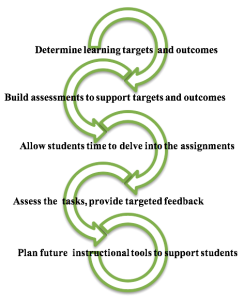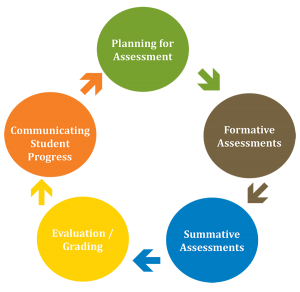
Principle #3
Formative assessment (for learning) must be ongoing, varied, and central to the instructional-learning cycle.
“If summative assessment can be described as a digital snapshot, formative assessment is like streaming video. One is a picture of what a student knows that is captured in a single moment of time, and the other is a moving picture that demonstrates active student thinking and reasoning”
—Van de Walle, Lovin, Karp & Bay-Williams, 2006
Assessment for learning (formative assessment), designed to improve learning and achievement, occurs throughout the instructional cycle. It does not involve grades and scores for assignments and tasks but instead turns assessments into learning events. Formative assessment provides opportunities for students to clarify their understanding prior to grading or scoring while not impacting final grades or scores.
 The focus of formative assessment is to provide students targeted feedback, during the unit of study, to guide students with the next step of their learning. To assess where students are, what they still need and where they need to go in their learning, requires multiple and varied assessments throughout the unit.
The focus of formative assessment is to provide students targeted feedback, during the unit of study, to guide students with the next step of their learning. To assess where students are, what they still need and where they need to go in their learning, requires multiple and varied assessments throughout the unit.
Assessment for learning is “designed to give teachers information to modify and differentiate teaching and learning activities. It requires careful design on the part of teachers so that they use the resulting information not only to determine what students know, but also to gain insights into how, when, and whether students apply what they know. Teachers can also use this information to streamline and target instruction and resources and to provide feedback to students to help them advance their learning”. (Western and Northern Canadian Protocol for Collaboration in Education (WNCP), 2006, pp.13–14).
ASSESSMENT CYCLE

TRY THIS
Click here for ideas to try in the classroom
1) Use a variety of pre-assessments tools such as:
- Webbing: Version 1 or version 2 or version 3
- Know-Wonder-Learn
- Pre-assessments /anticipation guides
- Know-Learned-Still Wonder
2) Conference with students about their learning and plan the next steps together.
3) Provide rubrics to students to enable them to see where they need to be.
4) Use quick formative assessment to check for understanding:
- Traffic Light
- Thumbs up, Thumbs down
- Exit slips
- Use models or exemplars
- See here for more descriptions and examples.
5) Use Visible Thinking Routines
6) Provide clear, descriptive, honest and supportive feedback – focus specifically on learning.
7) Use digital tools:
WATCH THIS
Click here to watch related video content
Dylan Wiliam: Formative Assessment
Watch as Dylan Wiliam reviews the nature of formative assessment and how teachers can use it to gain better insights into student learning and achievement.
Carol Dweck, “Developing a Growth Mindset”
Should you tell your kids they are smart or talented? Professor Carol Dweck answers this question and more, as she talks about her groundbreaking work on developing mindsets. She emphasizes the power of “yet” in helping students succeed in and out of the classroom.
READ THIS
Click here for additional reading suggestions
To learn more, check out these texts:
- Brookhart, S. (2008). How to give effective feedback to your students. Alexandria, Virginia. Association for Supervision and Curriculum Development.
- Crockett, L. & Churches, A. (2017). Mindful assessment: The 6 essential fluencies of innovative learning. Bloomington, Indiana. Solution Tree Press.
- Hattie, J., & Timperley, H. (2007). The power of feedback. Review of Educational Research, 77, 81-112.
- Shepard, Lorrie A. “The Role of Assessment in a Learning Culture.” Educational Researcher 29, no. 7 (Oct 2000): 4:14.
- Moss, C. & Brookhart, S. (2009). Advancing Formative Assessment in every classroom: A guide for instructional leaders. Alexandria, Virginia. Association for Supervision and Curriculum Development.
- Western and Northern Canadian Protocol for Collaboration in Education. (2006). Rethinking Classroom Assessment with Purpose in Mind.
